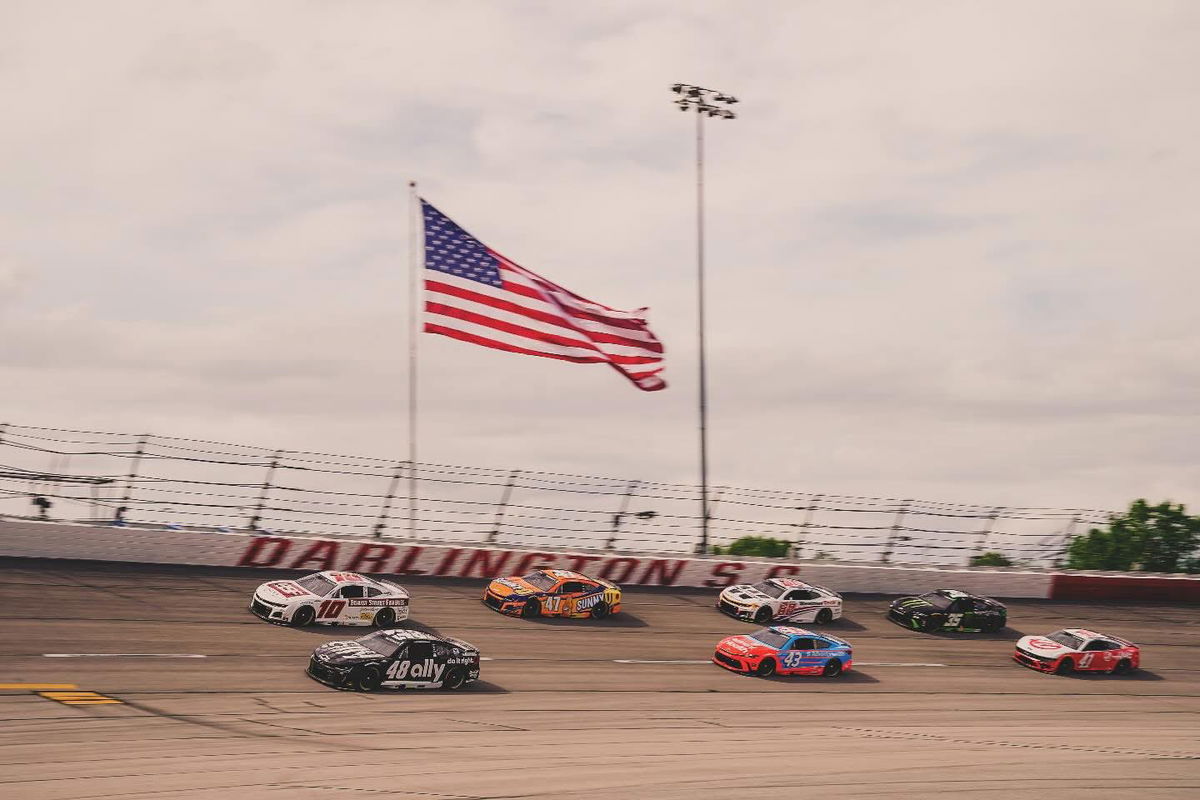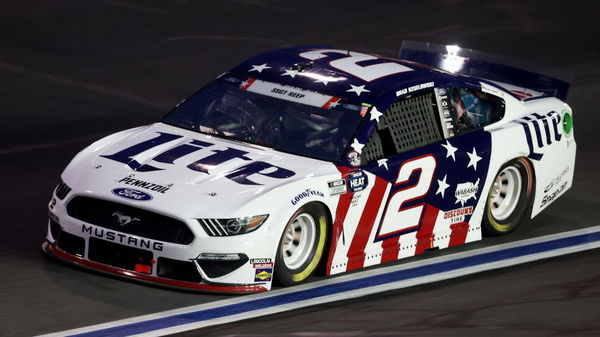

During the peak of a NASCAR season, heated rivalries are in full swing. Divisive factions spring up in the fandom, as people cheer loudly for their favorite Cup Series drivers. The roar of V8 engines and the rumble of the racetrack fuel that passionate competition. At the same time, those exciting sounds also foster a feeling of immense pride and freedom before the race.
Watch What’s Trending Now!
That feeling usually starts with the phrase, “Fans, at this time we ask that you please rise and remove your hats.” Every person in the grandstands then bows their head in unison, as the National Anthem plays during the pre-race activities. This happens on all 38 weekends of a full NASCAR season.
Military personnel salute the flag while veterans shed tears over tragic memories. As the anthem reaches “O’er the land and of the free,” a rumble can be heard from a distance. Suddenly, the crowd looks to the skies and erupts into joy. This is the flyover, where the planes and jets shake the stands and the fans to their cores.
ADVERTISEMENT
This cements the already solid legacy of patriotism that the sport harbors – and on Veterans Day, we remember all that sustains the patriotic elements of NASCAR.
Deep roots of American identity in NASCAR
When Junior Johnson was an established racer in the NASCAR circuit in 1955, he still continued to work in the family business – moonshining. In fact, the illegal transport of alcohol was at the heart of stock car racing. The sport had its roots in Appalachia, where producing and selling homemade whiskey offered respite to family farms seeking to escape crippling poverty, wrought by the Great Depression. Hence, bootlegging whiskey or hooch, albeit an unlawful activity that grew during the Prohibition era, provided a flavor of hard work, sacrifice, and risk to NASCAR, signifying key ideals of patriotism.
ADVERTISEMENT
Junior Johnson, a 50-time Cup Series race winner and NASCAR Hall of Famer, outlined how moonshining honed his racing skills as well. “Moonshining was part of my growing up, but it was also part of my training in auto racing,” Johnson told the St. Louis Post-Dispatch in 1990. “Being in that business, you had to have a very fast car and you had to be able to outrun the revenuers or highway patrol or sheriff or whoever tried to pursue you to try and apprehend you.”
In September 1945, shortly after World War II ended, a riot ensued at Lakewood Speedway as the police banned five racers accused of moonshining. They included Roy Hall, one of the top bootleggers of Georgia. 30,000 fans chanted in unison and demanded his release, with the authorities relenting eventually. Soon after, in December 1947, a top stock car driver named Bill France assembled the top moonshine runners, who were also the top racers, mechanics, and engineers, in a meeting. That gave rise to what we now know as NASCAR. And these stories of courage and skill reflect the very traits often celebrated as part of the American identity.
ADVERTISEMENT
Honoring heroes — NASCAR’s enduring bond with the military
While moonshine runners offered the grassroots basis of NASCAR’s patriotism, the sport has continued its traditional values in eclectic ways. One such way is the well-known honoring of the country’s most respected sector of people, the military. The foremost tradition of saluting American soldiers and martyred heroes is rooted in the Memorial Day Weekend. The prestigious Cup Series race of the Coca-Cola 600 features drivers proudly flaunting the colors and information of fallen soldiers on their cars. It serves to remember those who have made the ultimate sacrifice for the USA.
On this Memorial Day Weekend, we pause after Stage 2 to Honor and Remember our fallen heroes. #NASCARSalutes pic.twitter.com/XFJK0e2A80
— NASCAR (@NASCAR) May 26, 2025
ADVERTISEMENT
During the 2025 Coke 600, there was a special appearance of hundreds of service members, patriotic music, helicopters, and a 105 mm howitzer demonstration. One of the dignitaries present was George Lutz, whose son George Anthony Lutz was killed in Iraq in 2005. He said, “We know that NASCAR has some of the greatest patriotic fans in America. They understand sacrifice and understand patriotism.” Following his son’s departure for his heavenly abode, Lutz founded the national nonprofit “Honor and Remember.” It tries to recognize the sacrifice of America’s fallen service members and their families through support and unique experiences for Gold Star families.
But it’s not just for the day. NASCAR teams support veterans throughout the year. Many drivers like Brad Keselowski and Ryan Preece have partnered with organizations like Operation Homefront and the Wounded Warrior Project. Drivers often lead their own initiatives too, like visiting hospitals, raising funds, or providing resources to active-duty military and veterans.
ADVERTISEMENT
Honoring veterans through eclectic colors
While the Coca-Cola 600 race already pays a heavy tribute, NASCAR drivers time and again don some special colors. Among the most notable paint schemes are Jeff Gordon’s No. 24 red, white, and blue DuPont scheme at the 2010 Coca-Cola 600 or Brad Keselowski‘s No. 2 Penske Ford splashed with star-spangled colors at his 2020 Charlotte victory.

While such paint schemes are mainly from NASCAR’s end, even the military has pitched in. During Memorial Day weekend in 2022, Air Force Staff Sgt. Sabatino DiMascio designed the No. 31 Chevrolet Camaro SS as part of a contest. Marking the Air Force’s 75th anniversary, DiMascio said he picked a green paint scheme that paid homage to the C-47 Skytrains that flew over Normandy, France, during the early hours of D-Day during World War II.
NASCAR today — keeping the flame alive
In the present day, NASCAR continues to honor its patriotic and traditional values. And it continues to devise newer avenues to honor them, like the much-awaited 2026 plan of holding races in San Diego. Drivers will head to a challenging 16-turn, 3.4-mile street circuit located at Naval Base Coronado, resonating with the celebration of the 250th anniversary of the United States Navy.
The San Diego Weekend is on June 19th-June 21st, 2026. It features a quick right-hand turn after the Ellyson Start/Finish Line, before two quick 90-degree left-handers pull drivers on a fascinating journey around the San Diego Bay. Notably, the Ellyson Start/Finish Line was named in honor of Commander Theodore Ellyson, Naval Aviator Number One. His training at North Island laid the foundation for its commissioning as a naval air station in 1917 and eventual recognition as the “Birthplace of Naval Aviation.”
This unique event has already heartened many NASCAR drivers, including Cup Series star Ross Chastain. He said in September this year, “We do a pretty good job at our patriotism and showing it, but this is going to be a whole other level when we’re there on the base.”
Closing reflection — the true American spirit
Every NASCAR race begins with a profound remembrance of what patriotism means to Americans – from the precious lives lost to grassroots traditions. Such a tribute is integral to the core of the sport and to the core of every spirited fan. On Veterans Day, NASCAR becomes more than just a sport. It stands as a powerful symbol of gratitude, freedom, and unity, honoring those who have served and celebrating the values they protect.
ADVERTISEMENT
ADVERTISEMENT
ADVERTISEMENT

